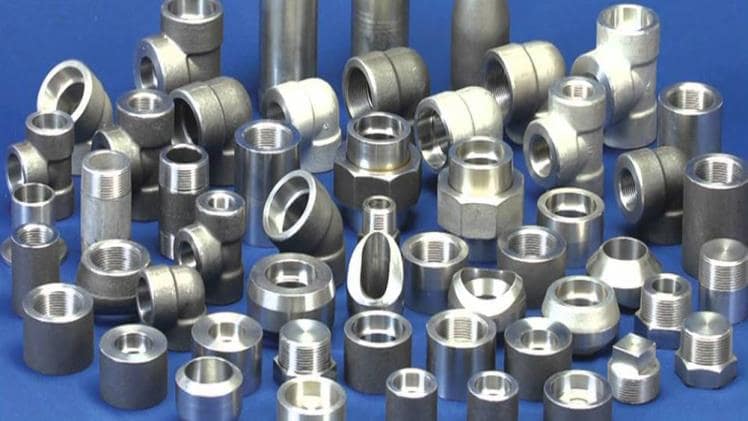Forged fitting is used to join together valves, pipes, pumps, and other equipment in order to form piping systems with 2 or 4 inches diameter. Socket-weld fittings and threading fittings are the two primary forms of forged fittings. Fillet welds link socket-weld fittings to pipes, while threaded fittings need the line to be screwed onto the fittings.
This is made of solid steel blocks machined to the final required shape within the tolerances established by the applicable criteria. Moreover, the fitting class indicates the maximum pressure that the item can bear.
What Are The Uses Of Forged High-Pressure Fittings?
High-quality high-pressure forged fitting and forged mining parts are made from the highest-quality raw materials and may be utilized in several applications. Forged fittings are completed with unmatched uniformity and dependability for extended life, high pressure, and zero faults.
High-pressure fittings are utilized in practically all industrial applications that need complicated threaded connections. For instance, it is used to test structures in the water. Fertilizers, nuclear thermal, instrumentation, oil gas, heat exchanger, pharmacy surgical industries, water gas-piping systems, and refineries petrochemicals are just a few of the other sectors that employ these fittings.
Moreover, high-pressure forged fittings are utilized in various applications that need high temperatures. It is used to transmit high-pressure fluids or gases from one location to another.
What Are The Different Grades Of Forged Fittings?
Forged fittings are available in a variety of materials and grades. The grades of forged fittings are shown below.
Duplex and Super Duplex Steel
This material is also chosen for use in the forging process, which creates a variety of items. F51, F53, F55, F44, F45, F60, and F61 are duplex and super duplex steel grades. All of these grades are included in ASTM and ASME A standards.
Stainless Steel
Stainless steel comes in various grades, including ASTM, ASME A, and SA 182. 304, 304L, 3034H, 309S, 309H, 309H, 316, 316H, 316L, 316LN, 310S, 310H, 317, 317L, 321, 321H, 347, 347H, and 904L. All of these grades may be used in the forging process. Furthermore, these qualities make forged fittings ideal for use in a wide range of sophisticated and general industrial uses.
Nickel alloy
Forged fittings are made of nickel alloy, available in ASTM, ASME SB 564, 160, and 472 specifications. UNS 2200 (Nickel 200), UNS 8825 (Inconel 825), UNS 4400 (Monel 400), UNS 6600 (Inconel 600), UNS 6625 (Inconel 625), UNS 6601 (Inconel 601), UNS 10276 (Hastelloy C 276), UNS 10276 (Hastelloy C 276), and UNS 2201 (Hastello (Nickel 201). These grades are appropriate for developing fittings, allowing them to withstand a certain degree of stress in industrial settings.
Carbon Steel
One of the most common materials for forged fittings is carbon steel. ASTM 105, A694, A350 LF2, and A350 LF3 are some of the standards available for this alloy. F42, F46, F60, F65, F52, F56, and F70 are the grades for carbon steel. Forged fittings made from carbon steel grades are sturdy and long-lasting in various industries.
Copper alloy
UNS No C92200, UNS No 70600, 71500, C 70600 (Cu-Ni 90/10), UNS No C 83600, C 71500 (Cu-Ni 70/30), UNS No C 10100, C 10200, C 10800, C 10300, C 12000, and C 12200 (Cu-Ni 90/10), UNS No C 83600, C 71500 (Cu-Ni 70/30), UNS No C 83600 are the grades for copper alloy. Every one of these copper alloy grades is utilised in forged fittings, and they are all listed in ASTM, ASME SB 151, 152, 61, and 62 standards.
Alloy Steel
There is just one standard for alloy steel: ASTM A182. F1, F9, F5, F11, F22, and F91 are among the available grades. These grades are appropriate for use in the production of forged fittings by industry standards.
Brass
Brass is also employed in the production of forged fittings. Brass CA 360, CA 345, CA 377, SAE J531, SAE J530, and ASA are just a few of the grades offered. All of these grades are readily accessible on the market, allowing forged fittings to be used in various industries.
Types of Forged Fittings
Tees
Tees are forged steel fittings used to mix or split work processes. Reduced tees allow for pipe size changes.
Elbows
A pipe elbow is a forged fitting that allows a shift in direction, commonly in the 90° or 45° path, across two lengths of pipe or tube.
Couplings
Half-couplings are screwed into the pipe, while the other end is designed to be snugly fitted or welded onto the opposite end of the barrel or vessel.
Unions
Unions are forged fittings similar to couplings yet allow for easy disengagement and connection. They are made up of three parts: a nut, a female end, and a male end.
Bushings
Bushings and reducing inserts are forged fittings that allow for pipe size changes.
Caps
Caps are forged fittings that fit over the end of the pipe to stop the flow.
Plug
Plugs, like caps, are forged fittings that are put into the tube’s end and available in various head styles, such as hex, square, and round.
Cross
Crosses are forged fittings with one input and three outlets or vice versa. Four-way tees are another name for this kind of tee.
Forged fitting are available in various sizes and are designed for industrial application. They are offered as threaded or plugged weld fittings. You will have no trouble getting cost-effective plumbing system components if you work with the correct source.

